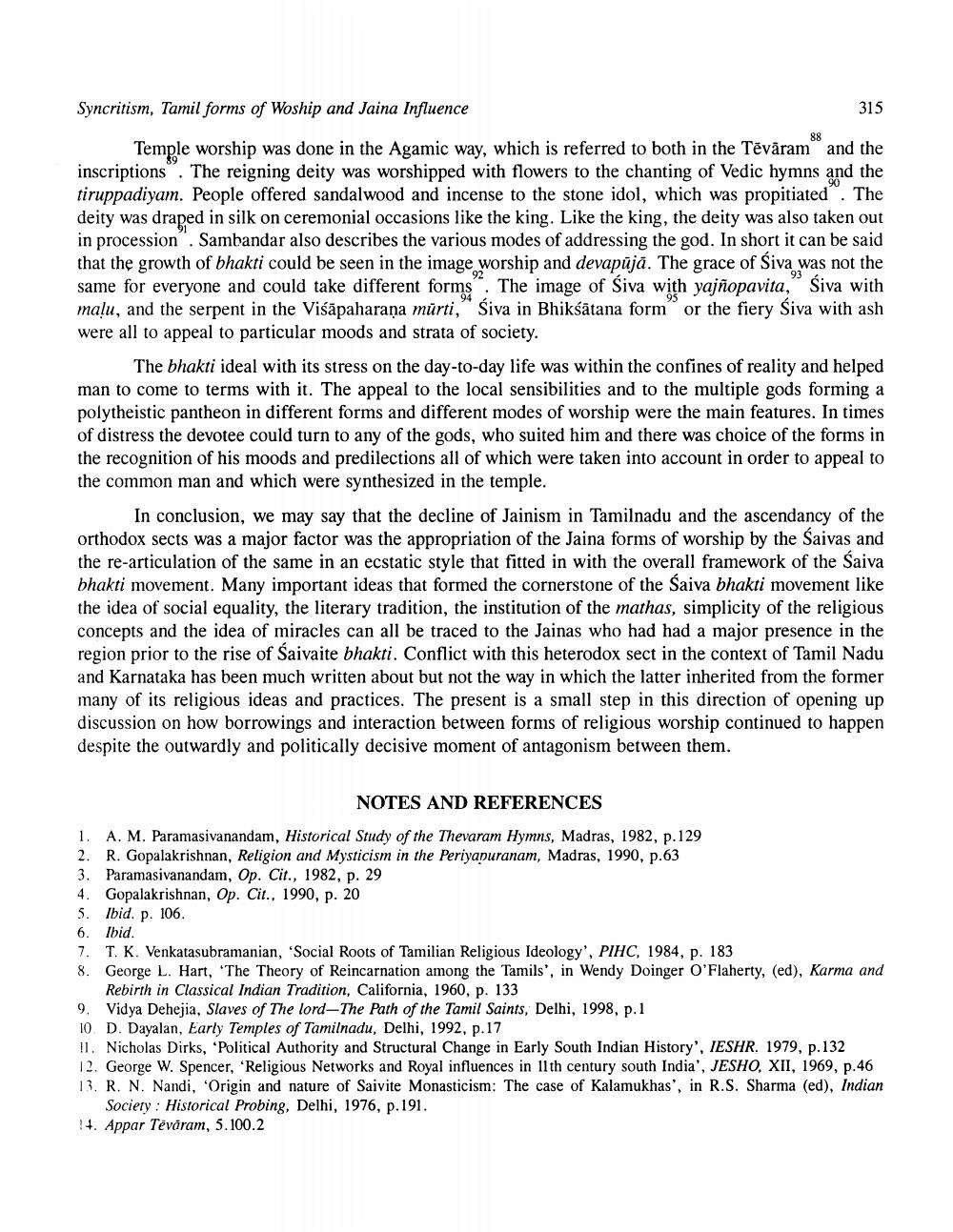________________
315
Syncritism, Tamil forms of Woship and Jaina Influence
Temple worship was done in the Agamic way, which is referred to both in the Tēvāram and the inscriptions. The reigning deity was worshipped with flowers to the chanting of Vedic hymns and the tiruppadiyam. People offered sandalwood and incense to the stone idol, which was propitiated. The deity was draped in silk on ceremonial occasions like the king. Like the king, the deity was also taken out in procession". Sambandar also describes the various modes of addressing the god. In short it can be said that the growth of bhakti could be seen in the image worship and devapūjā. The grace of Siva was not the same for everyone and could take different forms. The image of Siva with yajñopavita, Siva with malu, and the serpent in the Visāpaharaņa mūrti, Siva in Bhiksātana form or the fiery Siva with ash were all to appeal to particular moods and strata of society.
The bhakti ideal with its stress on the day-to-day life was within the confines of reality and helped man to come to terms with it. The appeal to the local sensibilities and to the multiple gods forming a polytheistic pantheon in different forms and different modes of worship were the main features. In times of distress the devotee could turn to any of the gods, who suited him and there was choice of the forms in the recognition of his moods and predilections all of which were taken into account in order to appeal to the common man and which were synthesized in the temple.
In conclusion, we may say that the decline of Jainism in Tamilnadu and the ascendancy of the orthodox sects was a major factor was the appropriation of the Jaina forms of worship by the Saivas and the re-articulation of the same in an ecstatic style that fitted in with the overall framework of the Saiva bhakti movement. Many important ideas that formed the cornerstone of the Saiva bhakti movement like the idea of social equality, the literary tradition, the institution of the mathas, simplicity of the religious concepts and the idea of miracles can all be traced to the Jainas who had had a major presence in the region prior to the rise of Saivaite bhakti. Conflict with this heterodox sect in the context of Tamil Nadu and Karnataka has been much written about but not the way in which the latter inherited from the former many of its religious ideas and practices. The present is a small step in this direction of opening up discussion on how borrowings and interaction between forms of religious worship continued to happen despite the outwardly and politically decisive moment of antagonism between them.
NOTES AND REFERENCES
1. A. M. Paramasivanandam, Historical Study of the Thevaram Hymns, Madras, 1982, p.129 2. R. Gopalakrishnan, Religion and Mysticism in the Periyapuranam, Madras, 1990, p.63 3. Paramasivanandam, Op. cit., 1982, p. 29 4. Gopalakrishnan, Op. cit., 1990, p. 20 5. Ibid. p. 106. 6. Ibid. 7. T. K. Venkatasubramanian, 'Social Roots of Tamilian Religious Ideology', PIHC, 1984, p. 183 8. George L. Hart, 'The Theory of Reincarnation among the Tamils', in Wendy Doinger O'Flaherty, (ed), Karma and
Rebirth in Classical Indian Tradition, California, 1960, p. 133 9. Vidya Dehejia, Slaves of the lord-The Path of the Tamil Saints, Delhi, 1998, p. 1 10. D. Dayalan, Early Temples of Tamilnadu, Delhi, 1992, p.17 11. Nicholas Dirks, Political Authority and Structural Change in Early South Indian History', IESHR. 1979, p.132 12. George W. Spencer, Religious Networks and Royal influences in 11th century south India', JESHO, XII, 1969, p.46 13. R. N. Nandi, 'Origin and nature of Saivite Monasticism: The case of Kalamukhas', in R.S. Sharma (ed), Indian
Society : Historical Probing, Delhi, 1976, p.191. ! 4. Appar Tēvāram, 5.100.2




